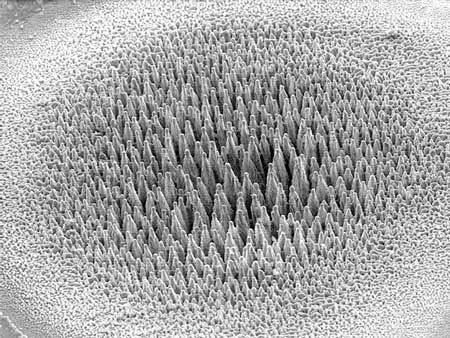| Posted: Jun 19, 2018 |
The fingerprints of harmful molecules could be detected noninvasively via black silicon
(Nanowerk News) Scientists of the Far Eastern Federal University (FEFU) in cooperation with colleagues from the Russian Academy of Sciences (RAS), Australian and Lithuanian Universities have improved the technique of ultrasensitive nonperturbing spectroscopic identification of molecular fingerprints.
|
|
A group of physicists experimentally confirmed that molecular fingerprints of toxic, explosive, polluting and other dangerous substances could be reliably detected and identified by surface-enhanced Raman spectroscopy (SERS) using black silicon (b-Si) substrate. The results of the work are published in the scientific journal Nanoscale ("Chemically non-perturbing SERS detection of a catalytic reaction with black silicon").
|
 |
| The needle-shaped surface structure of black silicon where needles are made of single-crystal silicon. The nanomaterial is absolutely chemically inert, non-invasive, and could support a strong and non-distorted signal. (Image: Far Eastern Federal University)
|
|
"When detecting the smallest molecules using SERS spectroscopy their interaction with the nanostructured substrate - the platform allowing ultrasensitive identification - is crucial", the head of research team Alexander Kuchmizhak, Ph.D., reported. Alexander is a researcher of the Department of Theoretical and Nuclear Physics of the School of Natural Sciences of the FEFU. He also added: "Currently noble metals-based substrates are chemically active and as a result, they distort the characteristic molecules signals."
|
|
"Due to its' special morphology black silicon significantly enhances the signal from the molecules wanted. This nanomaterial doesn't support catalytic conversion of the analyte as it could be in the case of the metal-based substrates applying. The 'black silicon'- based substrate is unique: being absolutely chemically inert and non-invasive it could support a strong and non-distorted signal," told Alexander Kuchmizhak.
|
|
The substrate can be fabricated by using the easy-to-implement scalable technology of plasma etching, thus has good prospects for commercial implementation. Such inexpensive non-metallic substrates with high accuracy of detection can be promising for routine SERS applications, where the non-invasiveness is of high importance.
|
|
Valuable properties of black silicon were discovered thanks to extensive scientific cooperation. Samples of the material were developed and provided by Australian colleagues, experimental work was carried out in the laboratories of the Institute of Chemistry and the Institute of Automation and Control Processes of the Far Eastern Branch of the RAS, as well as in the Scientific and Educational Center "Nanotechnologies" of the Engineering School of the FEFU.
|

